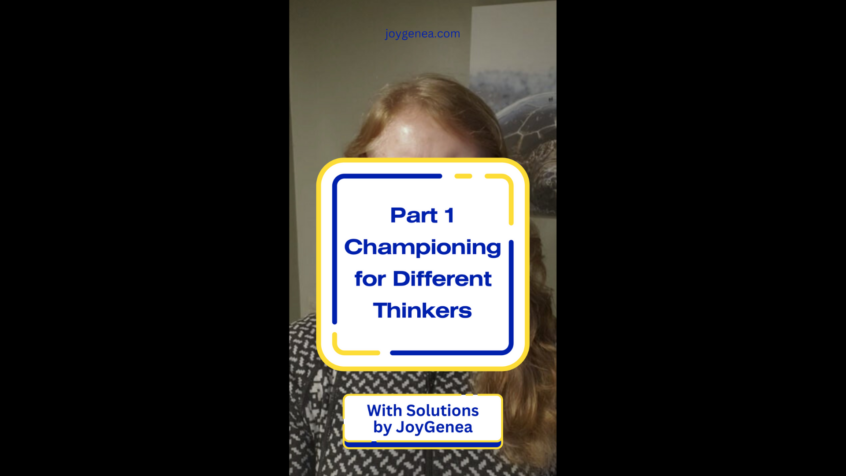It takes a team of allies to effectively support different thinkers in the workplace, school, or any other organization. This is the first installment of a 3-part series. Follow along for more.
CLICK HERE for an in depth blog about Championing Different Thinkers.
CLICK HERE for part 2 of the series.
CLICK HERE for part 3 of the series.
Transcription:
Hi, JoyGenea here, International Neurodiversity coach, talking about dyslexia and ADHD as always, and today I wanted to talk about championing those people that are different thinkers. So, we aren’t even just talking about ADHD and dyslexia. I’m talking about a little autism maybe, I’m just talking about people that maybe are struggling with massive anxiety or a little anxiety, how about some depression, like that’s different thinking too. That gets in the way at times also or creates just creates a different perspective and so forth. So, I’ve been asked, a variety of times over the years by employers actually, how they bring in, um in particular if it’s a very male-dominated work environment, how they bring in and have success integrating in more um females into that environment and I talk a lot about my own experiences with that, and I encourage them and these are a lot of the steps that I encourage them to take on, and they really um work well also for dyslexic thinkers when you’re working on integrating that or when you’re moving into a new job environment possibly or are in a job environment but want it to shift, you can actually change some of that.
So, this is part 1 of that conversation. So, the first thing I really encourage people to know about this is, I- the dyslexic or ADHD thinker, the different thinker actually can’t champion all of this by themselves and its actually really unsuccessful if they’re the only person having this conversation about these topics, and why that is, is because so often um other people only hear it, and then thereby only associate it with that one person, they don’t recognize and hear it from a wide variety of people recognizing it as a society thing, not a one-person thing. So, it’s really important that they’re not, that I’m not asked to give my own presentation on dyslexia, that I actually ask some other people to or that they bring in consultants, if this were a job, that type of thing, it needs to come from a variety of people. The most success I’ve ever seen with that actually was when I was asked to do a presentation like that, they’re like, “Well we’d like everybody, you know, here to understand dyslexia more.” And I said, “Ok,” and so I actually went around, there were 100 employees, I went around real quickly and was able to meet well over half of them, and just ask if they knew anybody that um struggled in school and was possibly diagnosed with dyslexia or ADHD. They did and I asked those people to actually share some of the stories of their nieces, their children, their nephews, um their parents actually. There were some great stories, and so what I put together was more like a TED Talk, and it wasn’t information just coming from me, and what was really powerful about that was I actually made some great allies and it turned out we connected on a lot of different levels, so that worked out really well, meant I had to be a little vulnerable, but it was ok in that environment and that was ok.
Also, if the person that’s the different thinker is championing for themselves all by themselves, there will be judgment, and what happens with that is there’s judgement that’s applied directly to that person that’s actually not associated with them, it’s just some assumptions that aren’t addressed or aren’t even known by the other people, and that that just can’t be handled like that, so they can champion for them- they can protect themselves obviously, and they can champion, but this is just part 1 of a 3-part series. So, listen on for additional ways about championing for a different thinker in a work environment, in an organization, at school, anywhere you can be a champion for a different thinker. It’s pretty simple. Thanks, bye now.
